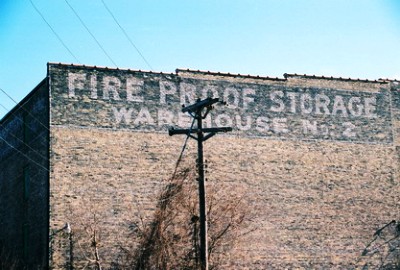"(St. Louis Cemetery #1) is the mother cemetery...the Vieux Carré of the dead; as confused and closely packed a quarter as the living metropolis." Grace King, author, 1895.
On my last evening in New Orleans I decided to go visit the oldest boneyard in New Orleans, St. Louis Cemetery #1, founded in 1789. Yes, on my last EVENING. I'm not sure why it didn't occur to me that the cemetery would be CLOSED at night. Maybe I thought I'd be able to peek through a fence or something (it's actually surrounded by a tall, white wall). In any case, the cemetery was outside the
safety-circle the desk clerk had drawn for me, but I wouldn't realize this until I got back to my hotel room.
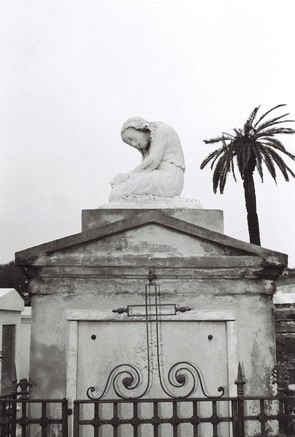 So, I set off, crossed Canal St., and kept going. I soon passed a man who bid me a very hearty "Good evening!" I responded in kind, and thought, "Very friendly folks around here!" About a block later I caught the vibe. Abandoned grocery store on one side, boarded-up building on the other. Very few people on the streets. My antennae went up. Way up. But I was pretty close, so, sun going down, I pressed on. Another guy walked past, and he, too, offered a friendly "Hello!" Only, this time, I thought I detected a trace of amusement in his tone. When I made it to the cemetery it was, of course, locked up tight as a drum. I circled it, just to feel like I'd accomplished something, and found a hole someone had bashed in the wall. It was large enough to crawl through and, incredibly, I actually considered squeezing in. Luckily, I realized that other people may have recently done the same thing and I didn't want to meet them under the circumstances. So, I turned around, kept my head down, and quickly walked back to my hotel in the dark. Failure.
So, I set off, crossed Canal St., and kept going. I soon passed a man who bid me a very hearty "Good evening!" I responded in kind, and thought, "Very friendly folks around here!" About a block later I caught the vibe. Abandoned grocery store on one side, boarded-up building on the other. Very few people on the streets. My antennae went up. Way up. But I was pretty close, so, sun going down, I pressed on. Another guy walked past, and he, too, offered a friendly "Hello!" Only, this time, I thought I detected a trace of amusement in his tone. When I made it to the cemetery it was, of course, locked up tight as a drum. I circled it, just to feel like I'd accomplished something, and found a hole someone had bashed in the wall. It was large enough to crawl through and, incredibly, I actually considered squeezing in. Luckily, I realized that other people may have recently done the same thing and I didn't want to meet them under the circumstances. So, I turned around, kept my head down, and quickly walked back to my hotel in the dark. Failure.
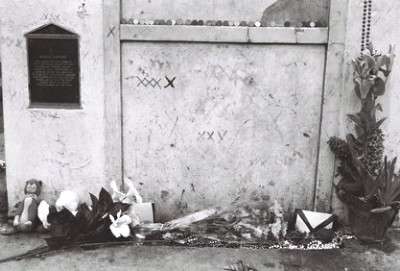
But, if at first you don't succeed, try, try, again. On my most recent trip to New Orleans I went to the cemetery first thing in the morning. This time it was open and there were plenty of tour groups out and about. A very different atmosphere. But I did appreciate the sign out front: "Visitors are welcome but enter these premises at their own risk." The graves are above-ground because the water table is so high that a heavy rain would have buried coffins popping up left and right. When space is needed, a coffin (at least 1 year and 1 day old) is removed, burned, and the remains pushed to the back of the tomb or set in a space below the vaults.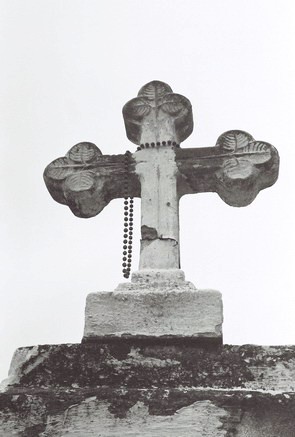 Homer Plessy (1863-1925), a black man who sat in a "whites-only" railroad car, leading to his role as plaintiff in Plessy v. Ferguson, is buried there. Remember, Plessy lost his case and the ruling put into law the "separate but equal" doctrine in the US. Also buried in the cemetery is Marie Laveau (1794?-1881?), the Voodoo Priestess. She and her daughter reportedly haunt the cemetery, and return fully to life on St. John's Eve (i.e. Midsummer's Eve), when they lead followers in a wild celebration (i.e. orgy). People requiring a little voodoo in their lives leave coins, stuffed animals, "X"'s--ANYTHING--to get Ms. Laveau to help them. Then, those in need turn around three times, knock thrice on the tomb, and their wishes are granted. Tradition has long held that the Laveau tomb is the one in the middle shot there, but the grave itself has always been unmarked. Did I try to get a little voodoo going on? Wouldn't you like to know. The statue in the top shot is "The Weeping Woman." This last photo features the ubiquitous beads of New Orleans. Thanks to Grave Addiction for providing some info on the Voodoo Queen. They've got lots of interesting photos and facts at the site if you want more. 'Til next time.
Homer Plessy (1863-1925), a black man who sat in a "whites-only" railroad car, leading to his role as plaintiff in Plessy v. Ferguson, is buried there. Remember, Plessy lost his case and the ruling put into law the "separate but equal" doctrine in the US. Also buried in the cemetery is Marie Laveau (1794?-1881?), the Voodoo Priestess. She and her daughter reportedly haunt the cemetery, and return fully to life on St. John's Eve (i.e. Midsummer's Eve), when they lead followers in a wild celebration (i.e. orgy). People requiring a little voodoo in their lives leave coins, stuffed animals, "X"'s--ANYTHING--to get Ms. Laveau to help them. Then, those in need turn around three times, knock thrice on the tomb, and their wishes are granted. Tradition has long held that the Laveau tomb is the one in the middle shot there, but the grave itself has always been unmarked. Did I try to get a little voodoo going on? Wouldn't you like to know. The statue in the top shot is "The Weeping Woman." This last photo features the ubiquitous beads of New Orleans. Thanks to Grave Addiction for providing some info on the Voodoo Queen. They've got lots of interesting photos and facts at the site if you want more. 'Til next time.
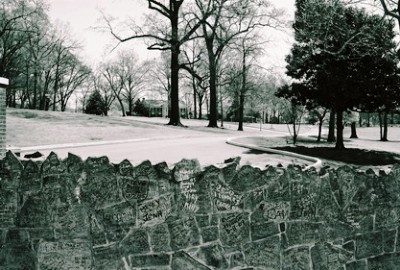
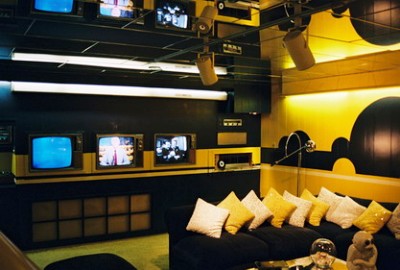

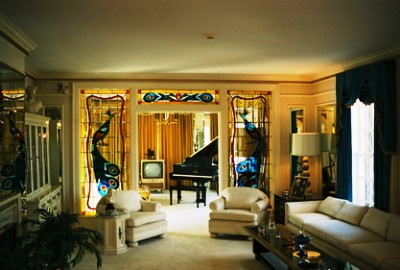
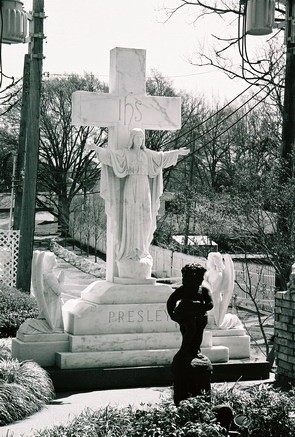 She had "Elvis I Love You" tattooed on her breast; When they landed in Memphis, well her heart beat so fast; She'd dreamed for so long, now she'd see him at last; She was down by his graveside day after day; Come closing time they would pull her away; Ah, to be with her sweetheart, oh, she'd left everything; From Galway to Graceland to be with The King; Ah, they came in their thousands from the whole human race; To pay their respects at his last resting place; But blindly she knelt there and she told him her dreams; And she thought that he answered or that's how it seemed; Then they dragged her away--it was handcuffs this time; She said, "My good man are you out of your mind?"; "Don't you know that we're married? See, I'm wearing his ring"; From Galway to Graceland to be with The King; "I come From Galway to Graceland to be with The King." Beautifully written by the one and only
She had "Elvis I Love You" tattooed on her breast; When they landed in Memphis, well her heart beat so fast; She'd dreamed for so long, now she'd see him at last; She was down by his graveside day after day; Come closing time they would pull her away; Ah, to be with her sweetheart, oh, she'd left everything; From Galway to Graceland to be with The King; Ah, they came in their thousands from the whole human race; To pay their respects at his last resting place; But blindly she knelt there and she told him her dreams; And she thought that he answered or that's how it seemed; Then they dragged her away--it was handcuffs this time; She said, "My good man are you out of your mind?"; "Don't you know that we're married? See, I'm wearing his ring"; From Galway to Graceland to be with The King; "I come From Galway to Graceland to be with The King." Beautifully written by the one and only 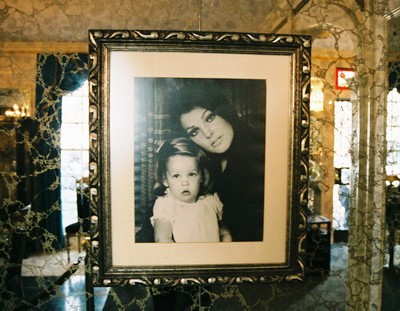
 So, I set off, crossed Canal St., and kept going. I soon passed a man who bid me a very hearty "Good evening!" I responded in kind, and thought, "Very friendly folks around here!" About a block later I caught the vibe. Abandoned grocery store on one side, boarded-up building on the other. Very few people on the streets. My antennae went up. Way up. But I was pretty close, so, sun going down, I pressed on. Another guy walked past, and he, too, offered a friendly "Hello!" Only, this time, I thought I detected a trace of amusement in his tone. When I made it to the cemetery it was, of course, locked up tight as a drum. I circled it, just to feel like I'd accomplished something, and found a hole someone had bashed in the wall. It was large enough to crawl through and, incredibly, I actually considered squeezing in. Luckily, I realized that other people may have recently done the same thing and I didn't want to meet them under the circumstances. So, I turned around, kept my head down, and quickly walked back to my hotel in the dark. Failure.
So, I set off, crossed Canal St., and kept going. I soon passed a man who bid me a very hearty "Good evening!" I responded in kind, and thought, "Very friendly folks around here!" About a block later I caught the vibe. Abandoned grocery store on one side, boarded-up building on the other. Very few people on the streets. My antennae went up. Way up. But I was pretty close, so, sun going down, I pressed on. Another guy walked past, and he, too, offered a friendly "Hello!" Only, this time, I thought I detected a trace of amusement in his tone. When I made it to the cemetery it was, of course, locked up tight as a drum. I circled it, just to feel like I'd accomplished something, and found a hole someone had bashed in the wall. It was large enough to crawl through and, incredibly, I actually considered squeezing in. Luckily, I realized that other people may have recently done the same thing and I didn't want to meet them under the circumstances. So, I turned around, kept my head down, and quickly walked back to my hotel in the dark. Failure. 

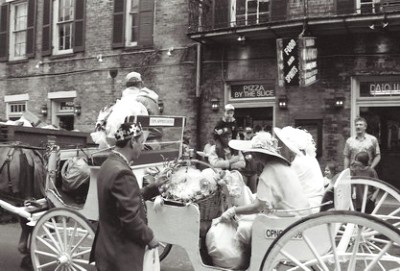
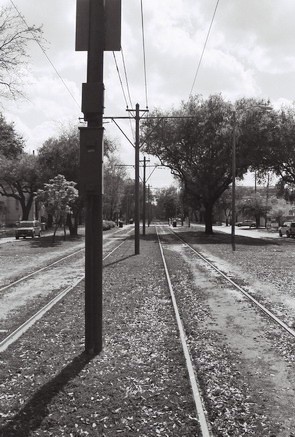 As darkness fell, a man trudged down the sidewalk, past burnt out buildings and overflowing trash cans, a TV hoisted on one shoulder, the power cord dragging behind him. My first night in London was spent in a basement hovel in Earl's Court, complete with pre-dawn knife fight outside the window. ("Aw, c'mon, just put that thing away before the police come," one guy finally pleaded. Surprisingly, it seemed the suggestion was taken, and I listened to their footsteps ricochet off in different directions.) And on and on. Trust me, I'm not showing off here. There's nothing particularly fun about winding up on the
As darkness fell, a man trudged down the sidewalk, past burnt out buildings and overflowing trash cans, a TV hoisted on one shoulder, the power cord dragging behind him. My first night in London was spent in a basement hovel in Earl's Court, complete with pre-dawn knife fight outside the window. ("Aw, c'mon, just put that thing away before the police come," one guy finally pleaded. Surprisingly, it seemed the suggestion was taken, and I listened to their footsteps ricochet off in different directions.) And on and on. Trust me, I'm not showing off here. There's nothing particularly fun about winding up on the 
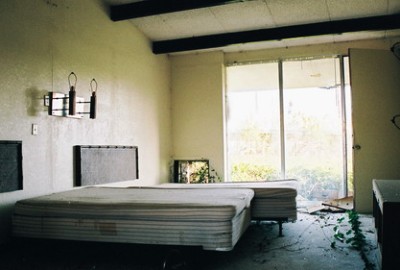
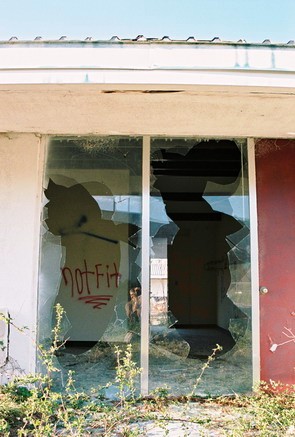 But, in each case, whatever occurred had to have been powerful. For this event, or sequence of events, transformed something that once must've meant everything--every hope, dream, or aspiration--and turned it into less than nothing. A rotting shell, the decaying objects inside, once cherished, now hardly the worst of it. A home become a place to flee. When I came across this motel in south Georgia, a little off I-75, I took the broken glass and shattered wood to be proof of calamity. Each room individually decorated, a children's playground out back, a laundry facility. Evidence of plans and passion. Now, nothing of use remained. To understand, to feel what might have been, you have to get close, and risk seeing something of yourself reflected back at you.
But, in each case, whatever occurred had to have been powerful. For this event, or sequence of events, transformed something that once must've meant everything--every hope, dream, or aspiration--and turned it into less than nothing. A rotting shell, the decaying objects inside, once cherished, now hardly the worst of it. A home become a place to flee. When I came across this motel in south Georgia, a little off I-75, I took the broken glass and shattered wood to be proof of calamity. Each room individually decorated, a children's playground out back, a laundry facility. Evidence of plans and passion. Now, nothing of use remained. To understand, to feel what might have been, you have to get close, and risk seeing something of yourself reflected back at you. 
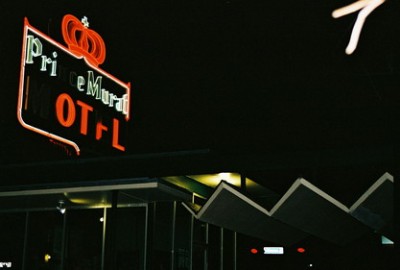
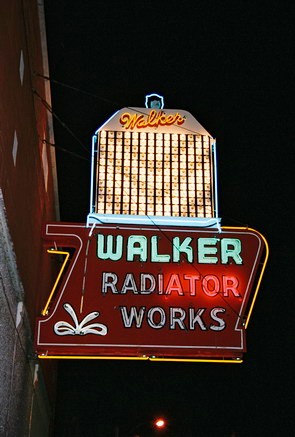
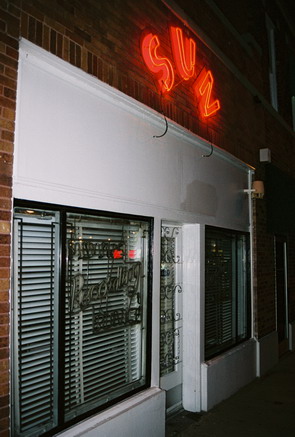 I feel like I'm cheating a little bit, since this shot was taken right next door to the radiator works. Yup,
I feel like I'm cheating a little bit, since this shot was taken right next door to the radiator works. Yup, 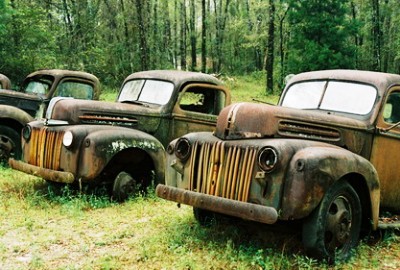
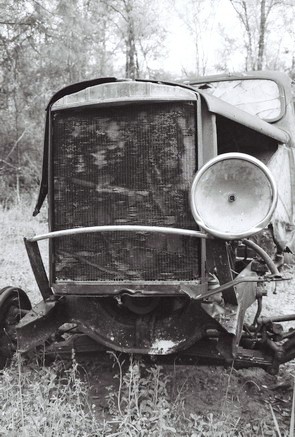 You know, the place where Elvis Presley was discovered by Sam Phillip's secretary, Marion Keisker. At first, Sam didn't think the kid had anything. But Marion pestered her boss for a year to bring him back in. And the rest, as they say, is history. The shot is of the room where Elvis, Howlin' Wolf, B.B. King, Johnny Cash, Jerry Lee Lewis, Roy Orbison, and so many others first did their thing. This is where Rocket 88, the original rock and roll song, was recorded by Jackie Brentson, with Ike Turner playing a mean piano. I won't tell you which page my shot is on--you should flip through and see for yourself. Yup, flip. The format is pretty cool, so take a look at Snaps Magazine.
You know, the place where Elvis Presley was discovered by Sam Phillip's secretary, Marion Keisker. At first, Sam didn't think the kid had anything. But Marion pestered her boss for a year to bring him back in. And the rest, as they say, is history. The shot is of the room where Elvis, Howlin' Wolf, B.B. King, Johnny Cash, Jerry Lee Lewis, Roy Orbison, and so many others first did their thing. This is where Rocket 88, the original rock and roll song, was recorded by Jackie Brentson, with Ike Turner playing a mean piano. I won't tell you which page my shot is on--you should flip through and see for yourself. Yup, flip. The format is pretty cool, so take a look at Snaps Magazine.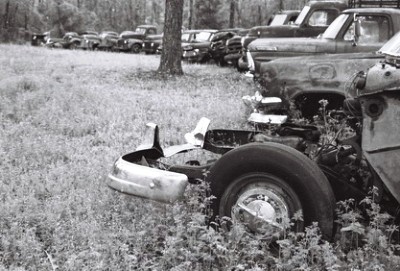
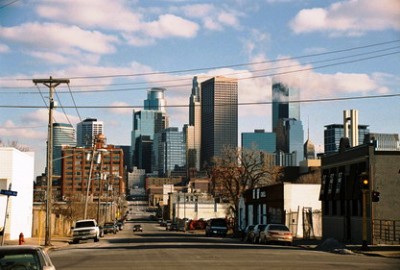
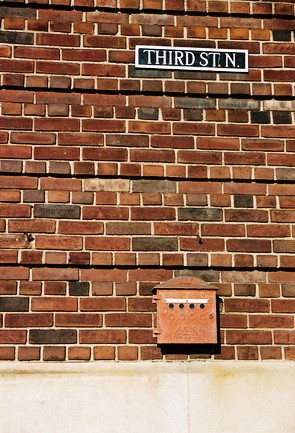 My friends and I started going downtown a lot, just roaming the streets on foot or bike. Sundays usually ended at the 7th St. Entry, 1st Avenue's small annex, where all ages punk rock shows were held. But Block E was considered a blight, and shortly after my first visit the whole thing was torn down. In one of those moves that is utterly baffling, yet so common it hardly elicits response, a parking lot was put in. Oddly, the parking lot sorta worked. It kept the area open and provided a handy meeting place. This was not what the city wanted, so some dumb-cluck got the bright idea to pipe classical music into the lot as a way to discourage the riff-raff from loitering. Naturally, it failed. The music only served to add an interesting contrast to the urban life happening all around.
My friends and I started going downtown a lot, just roaming the streets on foot or bike. Sundays usually ended at the 7th St. Entry, 1st Avenue's small annex, where all ages punk rock shows were held. But Block E was considered a blight, and shortly after my first visit the whole thing was torn down. In one of those moves that is utterly baffling, yet so common it hardly elicits response, a parking lot was put in. Oddly, the parking lot sorta worked. It kept the area open and provided a handy meeting place. This was not what the city wanted, so some dumb-cluck got the bright idea to pipe classical music into the lot as a way to discourage the riff-raff from loitering. Naturally, it failed. The music only served to add an interesting contrast to the urban life happening all around.